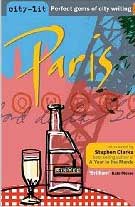Book Review: citi-lit Paris

- SUBSCRIBE
- ALREADY SUBSCRIBED?
BECOME A BONJOUR PARIS MEMBER
Gain full access to our collection of over 5,000 articles and bring the City of Light into your life. Just 60 USD per year.
Find out why you should become a member here.
Sign in
Fill in your credentials below.
 This is necessarily an odd book. To assemble citi-lit Paris, the newest companion to the previous books about Dublin, London, Amsterdam, and Berlin, editor Heather Reyes of Oxygen Books, a British publisher, has found passages from several dozen writers, ranging in time from Hugo and Maupassant to contemporary writers like Agnès Poirier and Adam Gopnik to define, if that is possible, the city. A wide selection like this across many different topics from the pens of so many different writers inevitably has produced some clunkers that never should have been written and should not have been collected in an anthology. This is a matter of taste (in this case, my taste), but it’s pretty safe to say that anyone’s taste will be gratified or soured in about equal measure to mine. The problem is not the editor’s fault, but—as she notes—no city has been more written about than Paris and anyone trying to give a broad picture is going to have a few blots and drips here and there.
This is necessarily an odd book. To assemble citi-lit Paris, the newest companion to the previous books about Dublin, London, Amsterdam, and Berlin, editor Heather Reyes of Oxygen Books, a British publisher, has found passages from several dozen writers, ranging in time from Hugo and Maupassant to contemporary writers like Agnès Poirier and Adam Gopnik to define, if that is possible, the city. A wide selection like this across many different topics from the pens of so many different writers inevitably has produced some clunkers that never should have been written and should not have been collected in an anthology. This is a matter of taste (in this case, my taste), but it’s pretty safe to say that anyone’s taste will be gratified or soured in about equal measure to mine. The problem is not the editor’s fault, but—as she notes—no city has been more written about than Paris and anyone trying to give a broad picture is going to have a few blots and drips here and there.
So much for warnings. citi-lit Paris (the lower case seems to be a trademark or signature) is a lot of fun. The selections are short and grouped roughly according to topic, e.g., “Le menu” has stories about food but also café life. Their brevity gives the reader a sense of picking a truffle (or an occasional pickle) off a plate on a nicely set table, since each selection has a brief introduction, and the arrangement according to broad topics helps readers navigate to what interests them most.
If you simply cannot express your love of Paris sufficiently, the first section, naturally called “I love Paris,” will give you the words you somehow have not been able to find. If you want to know more about Parisian cemeteries, you’ll find eight stories about the cities of the dead, but seven about Parisian high-life—a slightly macabre imbalance, but Père Lachaise and his brethren are actually kind of lively, in fact and in these stories.
There are moments in some accounts of absolutely startling accuracy. Adam Gopnik describes a man who ate green beans in Paris after the second world war and declares they changed his palate, perhaps even his life: as he finished telling his story, “He suddenly sat bolt upright, his eyes alight with memory.” Anyone who grew up on indifferent (a kind word) food in the States or, worse, in Great Britain and finally had a meal in Paris, if only a plate of haricots verts, will feel a pleasant shock of recognition or fellow-feeling, the bright light of memory taking hold, as romantic as the first love-making, as high as the first joint.
There are other moments like this one, and I have no intention of spoiling the reader’s sense of surprise with a catalogue. The joy and, I think, the purpose of this book is just that—to surprise the reader with a wonderful and unexpected pleasure—and, no less, to offer many points of view. If I have a reservation about the choices of writers, it is that some are represented too much, and others, like Anna Gavalda who reveals a humorous and sly feminism in her stories and my BonjourParis colleague Joseph Lestrange, with his funny if affectionate skepticism about Paris and Parisians, are not represented at all.
Nonetheless, the voices and insights vary and the joys of reading and discovery are not so uniform that they feel like too much of a good thing: even when eating truffles, you want variety, and citi-lit Paris is a buffet, un self de plaisirs littéraires. Help yourself, and enjoy.
© Budd Whitebook
More in book, book preview, Paris books


